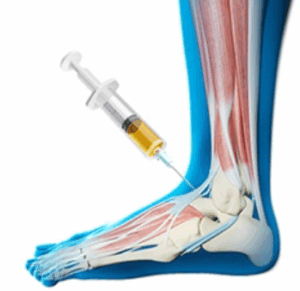Healing from Within: The Power of Platelet-Rich Plasma (PRP) Therapy & Regenerative Injections
September 22 2025
Modern medicine has made incredible strides in helping people recover from injuries, manage chronic pain, and improve overall quality of life. Yet, for many, traditional treatments such as medications, cortisone injections, or even surgery may not always bring the desired results. This is where Platelet-Rich Plasma (PRP) Therapy and regenerative injections step in, offering a cutting-edge yet natural solution that harnesses the body’s own healing potential.

What is PRP Therapy?
Platelet-Rich Plasma (PRP) therapy is a regenerative medicine technique that uses the patient’s own blood to promote healing. Here’s how it works:
- Blood Collection – A small sample of your blood is drawn, just like in a standard lab test.
- Centrifugation – The blood is spun in a centrifuge, separating the red and white blood cells from the plasma and platelets.
- Concentration – The result is plasma that contains a much higher concentration of platelets than normal—packed with growth factors that accelerate tissue repair.
- Injection – This platelet-rich plasma is carefully injected into the injured or inflamed area, stimulating healing where your body needs it most.
Because PRP is created from your own blood, it is considered safe, biocompatible, and free from the risks associated with foreign substances.
Conditions PRP Can Help With
PRP therapy is increasingly being used for a wide variety of musculoskeletal conditions, especially where traditional methods fall short. Common conditions include:
- Plantar Fasciitis – A painful condition affecting the heel and bottom of the foot, often seen in runners and those on their feet for long hours.
- Tendon Injuries – Chronic tendonitis or tendon tears, such as tennis elbow, golfer’s elbow, or rotator cuff injuries.
- Neuromas – Painful nerve tissue growths in the foot that cause burning or tingling sensations.
- Achilles Tendinopathy – Chronic irritation or degeneration of the Achilles tendon, common in athletes and active individuals.
- Ligament Injuries – Sprains or partial tears that haven’t responded well to rest and physical therapy.
Why Choose PRP Therapy Over Traditional Options?
Traditional treatments—like cortisone injections—are often designed to reduce pain and inflammation temporarily, but they don’t always encourage actual healing. PRP therapy stands out because:
- It promotes natural healing rather than masking symptoms.
- It reduces inflammation while stimulating tissue repair.
- It avoids surgery, which often comes with long recovery times and risks.
- It’s personalized, since the therapy is derived from your own blood.
In many cases, patients experience not only pain relief but also improved function and faster recovery.
What to Expect During and After the Procedure
PRP therapy is an outpatient procedure that typically takes less than an hour. After the injection:
- Some patients may feel mild soreness at the injection site for a few days.
- Healing is gradual, with many noticing improvements in pain and mobility within weeks.
- Multiple sessions may be recommended depending on the severity of the condition.
- Because the therapy works with your body’s natural healing process, results are long-lasting and may continue to improve over time.
The Science Behind PRP
Platelets play a critical role in wound healing. They release growth factors and proteins that stimulate:
- Cell regeneration
- New blood vessel formation (angiogenesis)
- Tissue repair and strengthening
By delivering a concentrated dose of these platelets directly to the site of injury, PRP accelerates the body’s normal repair mechanisms in a targeted way.
The Future of Regenerative Medicine
Regenerative therapies like PRP are part of a growing field in medicine focused on helping the body heal itself. For patients looking to avoid long-term medication use, invasive surgery, or recurring cortisone injections, PRP represents a promising alternative.
Doctors and researchers are also studying PRP for applications in arthritis, hair restoration, skin rejuvenation, and more. Its versatility and natural approach make it one of the most exciting frontiers in healthcare today.
Is PRP Therapy Right for You?
PRP therapy may be ideal if you:
- Have a chronic injury that hasn’t responded well to rest, physical therapy, or medications.
- Are an athlete seeking a faster, natural recovery.
- Want to avoid or delay surgery.
- Prefer biologic therapies that work with your body instead of against it.
A consultation with a qualified physician is the best way to determine whether PRP is appropriate for your condition.
Platelet-Rich Plasma (PRP) Therapy and regenerative injections are changing the way we approach injury recovery and chronic pain. By tapping into your body’s own healing abilities, PRP provides a safe, natural, and effective path to long-term recovery—helping you get back on your feet and back to the activities you love.
📞 Contact FFLC today to schedule an appointment. (239) 430-3668 (FOOT)
Serving Southwest Florida Since 2005, Family Foot & Leg Center has multiple convenient locations throughout Collier, Lee, Charlotte, and Sarasota Counties. Offering pediatric to geriatric family care: Ingrown Toenails, Heel Pain, Bunions, Foot / Ankle Arthritis Pain, Plantar Fasciitis, Foot / Ankle Surgery, Custom Orthotics, and Diabetic Wound Care. In office X-rays, ultrasounds, and minor surgical suite exam rooms. Practice powered by EMR and advanced technologies.
Home of the Lam Minimally Invasive No-Scar Bunion Surgery! Come Discover Why Patients Love Our 5-Star Foot & Ankle Care!
For advanced wound management and diabetic wound healing resources, visit:
👉 WoundHealingExperts.com
Same Day Appointments! Easy Online Appointment Scheduling.

 Fax: (239) 692-9436
Fax: (239) 692-9436 Tel: 239-430-3668
Tel: 239-430-3668